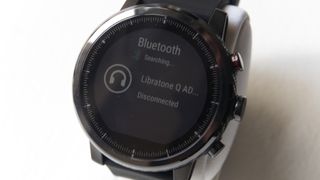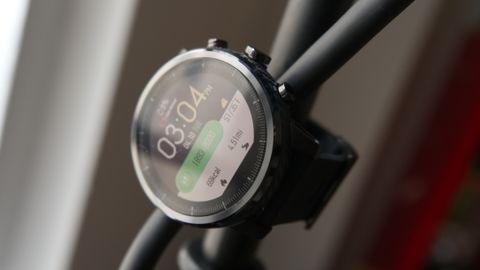Why you can trust TechRadar
Like most fitness trackers, the Amazfit Stratos (along with its other wearables) are compatible with iOS and Android smartphones. But unlike the others, the Stratos can do more without being synced up with your phone. It can track activities with its dedicated GPS chip and you can listen to locally stored music with a set of Bluetooth wireless headphones.
You’ll still need to initialize it with the Amazfit Watch app – oddly, the Mi Fit app that other Amazfit wearables utilize isn’t used at all. From there, it lets you more easily customize the watchfaces and other settings that are much harder to access on the watch itself.

There are few wearables companies who have a strong handle on the software side of things, and the Stratos proves that Amazfit isn’t one of them just yet. While the offerings are relatively friendly to new users and data-rich, it’s just a little strange that this uses a completely different app than the company’s other fitness trackers.
In terms of the watch’s battery life, it of course depends a lot on how you’re using it. Amazfit advertises a five-day battery expectancy and it definitely delivers on that promise. That’s after a healthy mix of activities, all of which utilized the GPS sensor and heart rate tracking. It’s worth noting that turning on continuous heart rate sensing and streaming music via Bluetooth are two very good ways of tanking the battery life. But should you just use it as a watch, you’re looking at more than a week of battery here.

Fitness
The Stratos is Amazfit’s most ambitious wearable, both in terms of its design and its fitness-ready features. If you’re scouring the market for a device that will be a reliable gym buddy, you’ll quickly realize how expensive most of the options out there are.
The Garmin Forerunner 645 Music, for example, has a similar set of features to the Stratos, but comes in at $399 (£399 / around AU$520). There are things that Garmin’s model, as well as others, accomplish with more prowess. Most notably is the interface, which does a better job packaging data on the screen, and more elegantly shows off the many duties of its hardware buttons.
But for about half the price, the Stratos does a whole lot in the fitness department. In terms of the workout types it can track natively, this includes running, walking, cycling, swimming, elliptical machine, mountain climbing and hiking, trail running, triathlon, tennis, soccer and skiing.
You can get granular with your fitness, should you desire. For example, the bottom button on the Stratos lets you trigger the lap function so you can time your reps if you’re aiming to get a lower time running around the local pond. Of course, something like this comes in handy when you’re swimming, which along with showering is a worry-free workout thanks to this watch’s waterproofing that can withstand five atmospheres of pressure.

No matter the workout, you can easily pause your progress by tapping the top button. From what we’ve seen, this watch doesn’t support auto-pause – something the Bip tried to questionable effect – but that’s no worry because if there’s something that fitness enthusiasts love, it’s direct control over their metrics.
GPS and GLONASS tracking isn’t the fastest we’ve seen – it can take around 15-20 seconds to find a lock. But you can still begin your workout while it boots up in the background. That said, it’s accurate, keeping a solid connection, and we enjoyed the GFX export feature that let us look at our tracked workouts on the big screen.
Are you a Strava user? If so, you’ll enjoy the fact that the Stratos can easily link up with the service, feeding in stats from the watch directly after setup. But if you don’t, the Amazfit app does a decent job of displaying your stats, offering a breakdown of each type of workout you achieved.
If you’re looking to squeeze as much utility as possible from the Stratos, the built-in heart rate sensor does a fine job. Continuous heart rate detection is toggled off by default to save battery, but switching it on will get you a constant feed of data.
Additionally, the Stratos also comes with support to sync with Bluetooth accessories like heart straps, as well as the ability track V02max, or how much oxygen you consume during a workout. Along with this metric, it can then gauge your exercise to determine how much recovery time you’ll need in order to grow. Simply put, it can do a lot for the price.
Current page: Compatibility, performance and fitness
Prev Page Intro, price and release date, design Next Page VerdictCameron is a writer at The Verge, focused on reviews, deals coverage, and news. He wrote for magazines and websites such as The Verge, TechRadar, Practical Photoshop, Polygon, Eater and Al Bawaba.

Inside the company making 35-year-old Game Boys look and work like new

AMD teams up with Arm to unveil AI chip family that does preprocessing, inference and postprocessing on one silicon — but you will have to wait more than 12 months to get actual products

The US takes another big step towards banning TikTok – here's what you need to know

